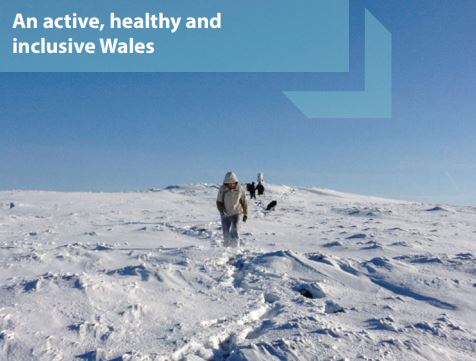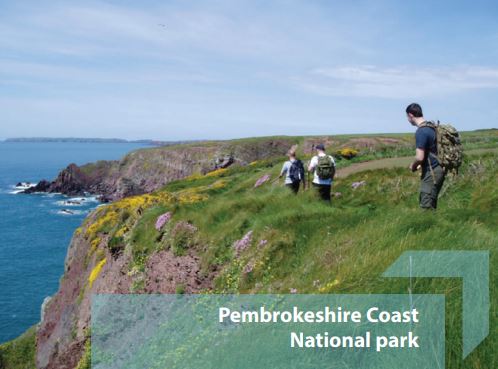Case Study
Walkability Project
Contact name
Hannah Buck & Paul Casson
Institution name
Pembrokeshire Coast National Park Authority
Region & country
Pembrokeshire Coast National Park , United Kingdom
Summary
In 2011 Pembrokeshire Coast National Park Authority hosted the Walkability Project, a ‘health asset’ securing benefits for the community, bringing together interested bodies including the Local Health Board, Leisure Services and the County Council. The Walkability Project, which uses walking to reduce sedentary behaviour and to improve participants’ fitness as well as health, developed from previous projects funded by Sport Wales that recognised the value of walking as a health intervention for cardiovascular health in adults. The project is now formally recognised as part of the Exercise Referral Scheme – a programme of activities designed for those who exercise only little, who suffer with one or more mild to moderate medical conditions or for those who have been identified as being at risk of developing such. The project has been successful in its main aim of encouraging and supporting the less able sector of the population to walk as part of a group and has also created a number of spin-off benefits.


Background of the project
The Exercise Referral Scheme is a programme of activities designed for those who are currently not active or exercising less than three times per week. It is also for those who suffer with one or more mild to moderate medical conditions, such as high blood pressure, arthritis, and depression; or have been identified as being at risk of developing these conditions. Participation in activities under the Exercise Referral Scheme involves a referral from a health professional, who believes that exercise will help in the prevention, management and improvement of the patient’s condition. People can then choose between gym based exercise or the Walkability Project which is introduced by this Case Study.
- The importance of improving the physical environment to encourage physical activity. In this the National Park authority has a responsibility to the network of public rights of way (footpaths) and the National Park is a ‘health asset’ has a key part to play in public health.
- To enhance independence and enable self-led recovery groups.
Solution and actions taken
The principle aims of the Walkability Project have been:
- To encourage and support individuals to walk as an alternative beneficial exercise.
- To provide participants with the skills and confidence to go walking in addition to the group sessions.
- To achieve progression in capacity for longer and/or more intense walking routes.
- The Walkability Project had provided a programme of fortnightly walks over a period of 12 months at a range of walking venues. The details were distributed to interested and potential participants by the Exercise Referral instructional staff operating through (Pembrokeshire County) Leisure Services. Participants were all registered with the Exercise Referral Scheme and relevant medical details were held by the instructors.
- By showing groups a selection of ‘doorstep’ walks they were empowered to repeat those themselves as an informal group on alternate weeks.
- More Exercise Referral Instructors and emerging volunteers will be trained as walk leaders as appropriate to increase the flexibility for increasing session numbers due to high demand.
Other institutions or parties involved
Results
Demand has been high and the cost of this therapy has been less than other comparable medical interventions. Based on 2013/14 budget, the cost per annum for a regular participant is approximately £300; this compares extremely favourably with other known medical preventative and rehabilitative interventions.
Based on 2013/14 budget, the cost per annum for a regular participant is approximately £300; this compares extremely favourably with other known medical preventative and rehabilitative interventions.
Demand has been high and the cost of this therapy has been less than other comparable medical interventions.
The project has been successful in its main aim of encouraging and supporting the less able sector of the population to walk as part of a group, however it has also created a number of spin-off benefits:
- it has trained walk leaders to enable other groups to start up; it has directly supported and advised other existing walking groups;
- it has been instrumental in making local people aware of the opportunities and resources available through their National Park;
- it has shown individuals, families and groups sites and routes that are suitable for their own use in their locality;
- it has raised the profile of walking activities within the county and now heads a consortium of organisations (Let’s Walk Pembrokeshire) who provide walking opportunities, and producing a publicly available ‘Walking Directory’ so that people can match their needs.
Challenges
- There are significant challenges in ensuring the sustainability of the project.
- The demand for the service outstrips the supply and this situation is anticipated to continue. The demand for the service outstrips the supply and this situation is anticipated to continue. With one employed project coordinator, & a small number of occasional qualified volunteer walk leaders, most groups only have access to a led walk every 2 weeks or a month, whereas weekly participation would bring much greater opportunity to engender healthier lifestyles.
- Sustainability through encouragement for individuals to take part in informal peer group walks has had some measure of success, but the client base is by nature one that contains people requiring support for activity to be undertaken. Even with some participant self-reliance meaning they move on, others replace them from an ageing local population and formation of new groups with newly identified needs.
- Statistically the numbers taking part have plateaued because the project is working at realistic capacity. There has also been an increase in the number of groups asking for support related to other areas of well-being other than cardio-respiratory fitness and rehabilitation, such as mental health, dementia, and elderly social isolation.
- Funding for the Walkability Project is reliant on bids to a variety of central government, health board, private enterprise and charitable sources, year on year. This has been the case, particularly with regard to funding from Welsh Government sources which has gradually reduced, and now stopped contributing to the day to day running of this and similar projects. The National Park is currently bearing the staffing and running costs, and although health board and other organization funding is being further investigated, commitment to this form of pro-active intervention is still verbal rather than monetary.
- Despite recognition of the value of this scheme, the signposting of walking as a therapeutic activity by GP surgeries, physiotherapists and other medical services has been poor. Despite numerous short-term pilot schemes and increased contact with community health professionals, the signposting remains sporadic and weak, with most new participants gaining information and encouragement from promotion by the National Park and local community organisations, and by word of mouth. Exercise Referral instructors are also extremely effective in signposting potential participants to walking groups as an alternative to exercise classes.
Lessons learned
- The evidence indicates that walking is an effective and enjoyable way to improve health outcomes for participants.
- Participant feedback consistently states enjoyment of the environment, and social aspect of involvement as their primary reasons to continue. The medical/health benefits are often seen as a very useful by-product.
- Provision of minibus transport and driver remains a key to the success of the project as a flexible, relevant service to the identified client base, as it is operating in a predominantly rural area with limited public transport resources. Requiring people to travel to designated meeting points, would be a barrier to many less physically able and those from disadvantaged or isolated communities.
- Travel costs for participants to the walks themselves needs to be kept at a minimum.
- Improved recognition, support and use by medical practitioners is needed to aid the sustainability of the scheme.
- The objective, scientific evidence continues to proliferate, and appears high profile and meets governmental and top level health approval, but is still not matched by either sufficient funding on the ground or by referral to services that are available.
- Volunteers have been a vital part of project delivery.
Contact name
Hannah Buck & Paul Casson
Institution name
Pembrokeshire Coast National Park Authority